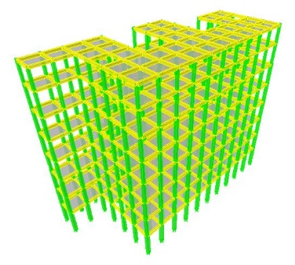Pengaruh Posisi Dinding Geser Terhadap Kinerja Struktur Pada Gedung Tidak Beraturan Dengan Menggunakan Metode Response Spectrum
Effect of Shear Wall Position on Structural Performance in Irregular Buildings Using the Response Spectrum Method
DOI:
https://doi.org/10.25299/saintis.2018.vol18(1).2809Keywords:
Dinding geser, respons spektrum, software ETABS, beban gempa, simpangan maksimumAbstract
[ID] Dinding geser adalah slab beton bertulang yang dipasang dalam posisi vertikal pada sisi gedung. Dinding geser merupakan salah satu sistem yang berfungsi menjaga kekakuan struktur, maka posisi dinding geser ditempatkan pada lokasi-lokasi tertentu, dengan itu penggunaan dinding geser dapat digunakan secara efektif dalam menahan beban yang diterimanya. Pemodelan struktur gedung dilakukan dengan bantuan software ETABS. Analisis beban gempa menggunakan metode respons spektrum. Pemodelan struktur dibuat untuk gedung tanpa menggunakan dinding geser dan 3 model gedung menggunakan dinding geser dengan posisi yang berbeda. Penentuan posisi dinding geser dilakukan dengan cara uji coba sehingga didapat posisi yang paling efektif. Perhitungan beban gempa mengacu pada pedoman SNI 1726-2012, beban mati berpedoman pada PPURG-1987 dan untuk beban hidup berpedoman pada SNI 1727-2013. Dari hasil perhitungan pada gedung tidak beraturan dengan metode respons spektrum didapat nilai untuk kinerja simpangan maksimum dari 4 model gedung. Simpangan maksimum arah sumbu x pada Gedung tanpa dinding geser sebesar 157,57 mm, pada gedung dengan dinding geser model 1 sebesar 123,41 mm, pada gedung dengan dinding geser model 2 sebesar 125,30 mm, pada gedung dengan dinding geser model 3 sebesar 94,46 mm. Simpangan maksimum arah sumbu y pada gedung tanpa dinding geser sebesar 193,13 mm, pada gedung dengan dinding geser model 1 sebesar 143,79 mm, pada gedung dengan dinding geser model 2 sebesar 141,16 mm, pada gedung dengan dinding geser model 3 sebesar 119,24 mm. Dari hasil kinerja simpangan maksimum pada Gedung tidak beraturan dengan metode respons spektrum didapat posisi dinding geser yang paling efektif adalah pada Gedung dengan dinding geser model 3
[EN] The Shear walls are reinforced concrete slabs that are installed vertically on the side of the building. Shear wall is one system that serves to maintain the rigidity of the structure, then the position of the shear wall is placed at certain locations, with the use of the shear wall can be used effectively in holding the load it receives. Building structure modeling is done with the help of ETABS software. Earthquake load analysis using the spectrum response method. Structural modeling is made for buildings without the use of shear walls and 3 building models use shear walls in different positions. Determination of the position of the shear wall is done by testing so that the most effective position is obtained. Calculation of earthquake load refers to the guideline of SNI 1726-2012, dead load is guided by PPURG-1987 and for live load is guided by SNI 1727-2013. From the results of calculations on irregular buildings with the spectrum response method obtained values for maximum deviation performance from 4 building models. The maximum deviation of the x-axis direction in Buildings without shear walls is 157.57 mm, in buildings with model 1 shear walls is 123.41 mm, in buildings with model 2 shear walls is 125.30 mm, in buildings with model 3 shear walls is 94.46 mm. The maximum deviation of the y axis direction in buildings without shear walls is 193.13 mm, in buildings with model 1 shear walls of 143.79 mm, in buildings with model 2 shear walls of 141.16 mm, in buildings with shear walls of model 3 of 119.24 mm. From the results of the maximum deviation performance in the irregular building with the spectrum response method obtained the most effective position of the shear wall is the Building with the shear wall model 3
Downloads
References
Bambang, Budiono, 2011. Konsep SNI Gempa 1726-201x. Makalah dalam Seminar HAKI.
Budiono, Bambang., dan Supriatna, Lucky., 2011.Studi Komparasi Desain Bangunan Tahan Gempa Dengan Menggunakan SNI 03-1726-2002 dan RSNI 03-1726-201X. Bandung: Penerbit ITB.
Departemen Pekerjaan Umum, 1987. Pedoman Perencanaan Pembebanan Untuk Rumah Dan Gedung. PPPURG. Jakarta.
Departemen Pekerjaan Umum, 2012. Tata Cara Perencanaan Ketahanan Gempa Untuk Struktur Bangunan Gedung. Jakarta.
Departemen Pekerjaan Umum, 2013. Persyaratan Beton Struktural Untuk Bangunan. Jakarta.
Departemen Pekerjaan Umum, 2013. Beban Minimum Untuk Perencanaan Bangunan Gedung Dan Struktur Lain SNI 03 – 1727 – 2013. Jakarta.
Nurcahyo, Heru, 2016, Kajian Posisi Shear Wall Pada Gedung Tidak Beraturan Berdasarkan Eksentrisitas Struktur Gedung. Tugas Akhir, Program Studi Teknik Sipil Fakultas Teknik Universitas Riau.
Rendra, Rezky, 2015, Analisis Kinerja Struktur Akibat Beban Gempa Dengan Metode Respon Spektrum dan Time History. Tugas Akhir, Program Studi Teknik Sipil Fakultas Teknik Universitas Riau.
Schueller, Wolfgang, 1989, “Struktur Bangunan Bertingkat Tinggi, PT. Bresco, Bandung.
Wight, J. K., and MacGregor, J. G., 2012. Reinforced Concrete Mechaics & Design. United States of America: Pearson Education, Inc.

Downloads
Published
Issue
Section
License

This work is licensed under a Creative Commons Attribution-ShareAlike 4.0 International License.
Copyright. This is an open access article which means that all content is freely available without charge to the user or his/her institution. Jurnal Saintis allows the author(s) to hold the copyright without restriction. The copyright in the text of individual articles (including research articles, opinion articles, and abstracts) is the property of their respective authors distributed under the terms of the Creative Commons Attribution-ShareAlike 4.0 International License which permits unrestricted use, distribution, and reproduction in any medium. Users are allowed to read, download, copy, distribute, search, or link to full-text articles in this journal without asking by giving appropriate credit, provide a link to the license, and indicate if changes were made.





